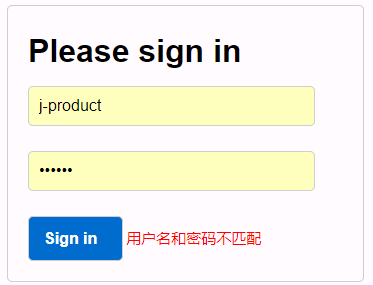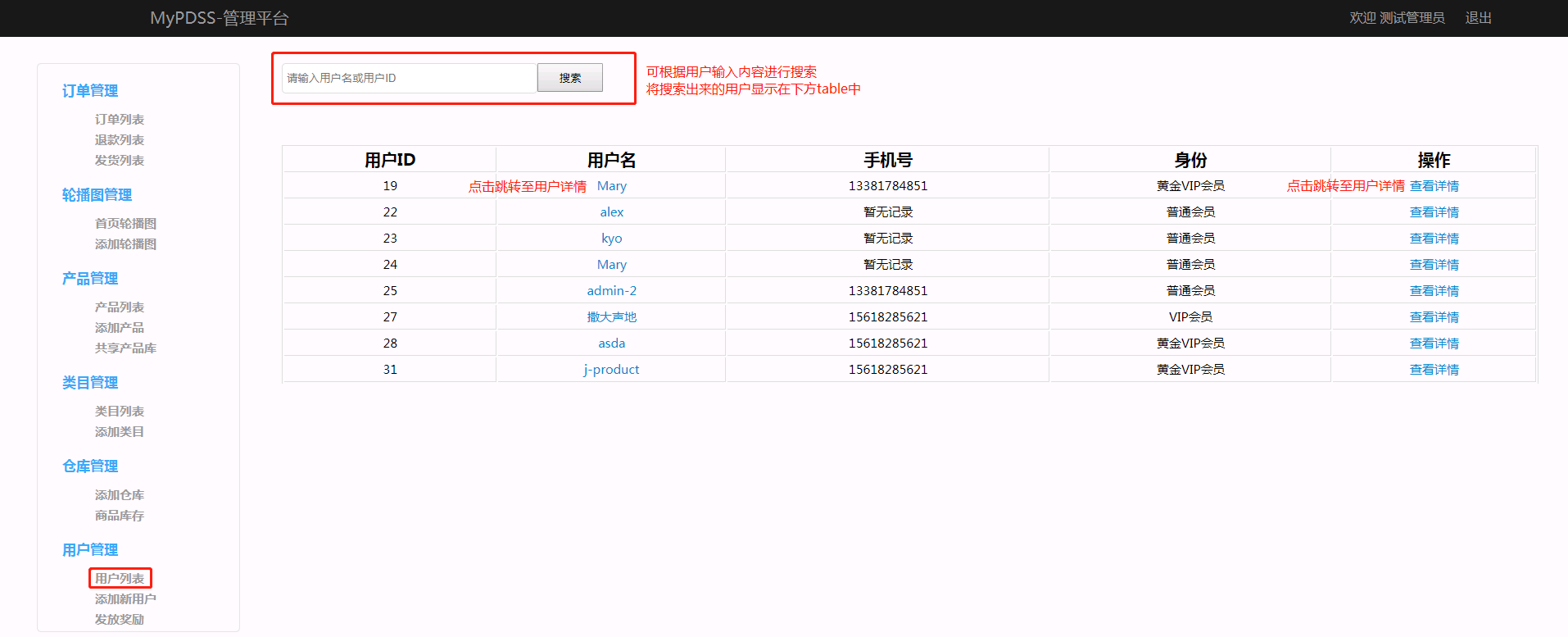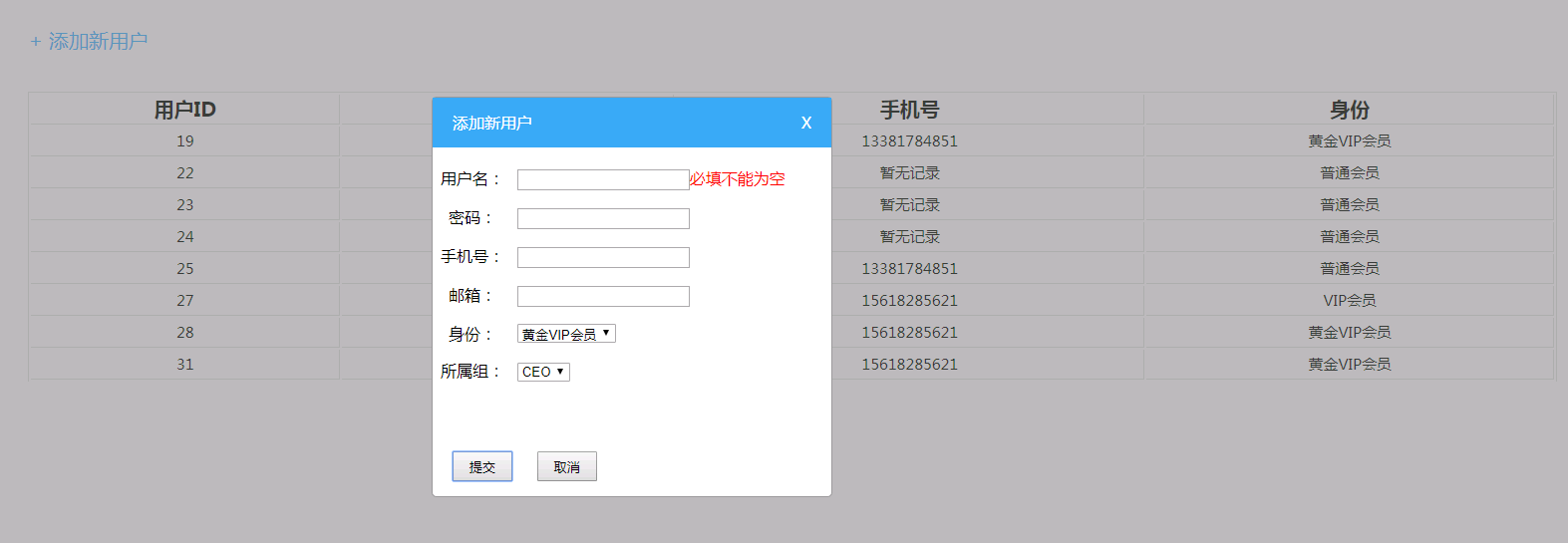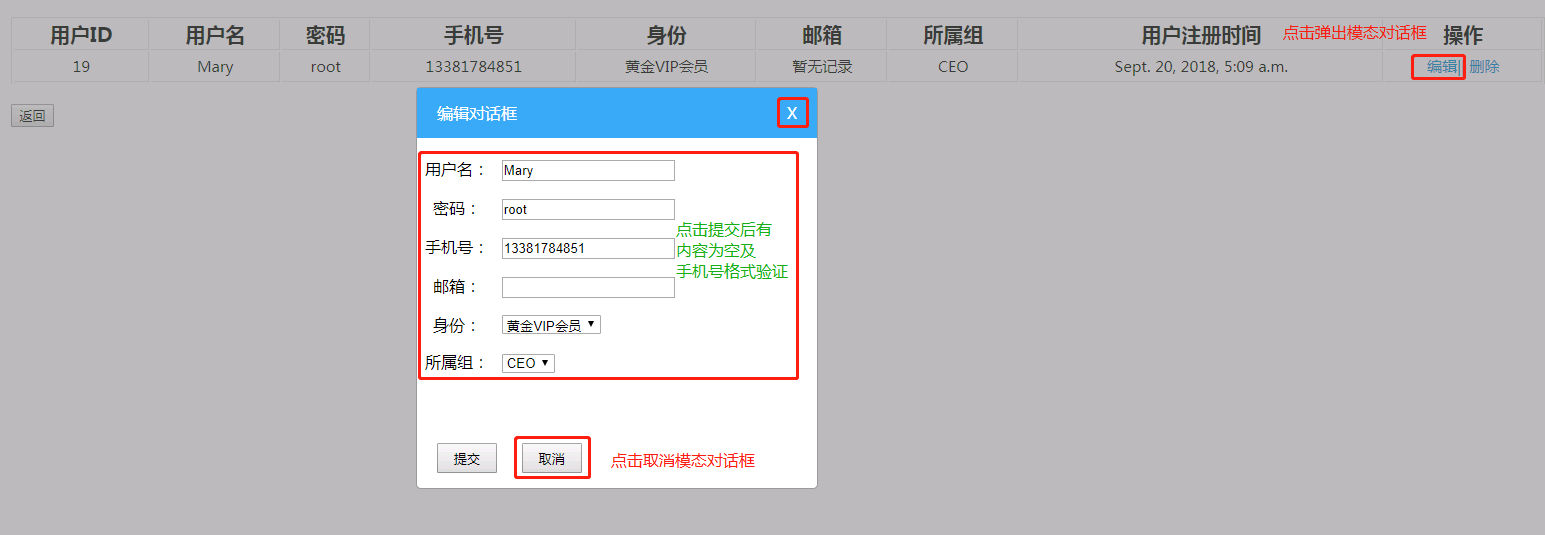老男孩Day18作业:后台用户管理
- 一、作业需求:
- 1、用户组的增删改查
- 2、用户增删该查
- - 添加必须是对话框
- - 删除必须是对话框
- - 修改,必须显示默认值
- 3、比较好看的页面
- 二、博客地址:https://www.cnblogs.com/catepython/p/9682884.html
- 三、运行环境
- 操作系统:Win10
- Python:3.6.4rcl
- Pycharm:2017.3.4
- 四、功能实现
- 1、完成了后台登录UI、数据交互(判断与验证)接口
- 2、搭建配置Django框架
- 3、后台管理整体页面布局
- 4、用户管理模块相关功能的实现
- 5、对用户信息通过后台对数据库操作实现了增删改查
- 五、测试
- 1、对各UI的跳转进行功能测试
- 2、对用户数据的数据接口测试
- 3、编辑框中对用户输入的信息做了验证和判断
- 六、备注
- 通过此次学习和实践
- 1、掌握了Django框架基础知识
- 2、对后台页面布局更加的熟练
- 3、也熟练运用掌握了ORM操作
readme
一、相关知识
- 1、Django请求生命周期
- -> URL对应关系(匹配) -> 视图函数 -> 返回用户字符串
- -> URL对应关系(匹配) -> 视图函数 -> 打开一个HTML文件,读取内容
- 2、创建django projcet
- django-admin startproject mysite
- ..
- mysite
- mysite
- - 配置文件
- - url.py
- - settings.py
- cd mysite
- python manage.py startapp cmdb
- mysite
- mysite
- - 配置文件
- - url.py
- - settings.py
- cmdb
- - views.py
- - admin.py
- - models.py # 创建数据库表
- 3、配置
- 模板路径
- 静态文件路径
- # CSRF
- 4、编写程序
- a. url.py
- /index/ -> func
- b. views.py
- def func(request):
- # 包含所有的请求数据
- ...
- return HttpResponse('字符串')
- return render(request, 'index.html', {''})
- retrun redirect('URL')
- c. 模板语言
- return render(request, 'index.html', {'li': [11,22,33]})
- {% for item in li %}
- <h1>{{item}}</h1>
- {% endfor %}
- *********** 索引用点 **********
- <h2> {{item.0 }} </h2>
- 一、路由系统,URL
- 1、url(r'^index/', views.index),
- url(r'^home/', views.Home.as_view()),
- 2、url(r'^detail-(\d+).html', views.detail),
- 3、url(r'^detail-(?P<nid>\d+)-(?P<uid>\d+).html', views.detail)
- PS:
- def detail(request, *args,**kwargs):
- pass
- 实战:
- a.
- url(r'^detail-(\d+)-(\d+).html', views.detail),
- def func(request, nid, uid):
- pass
- def func(request, *args):
- args = (2,9)
- def func(request, *args, **kwargs):
- args = (2,9)
- b.
- url(r'^detail-(?P<nid>\d+)-(?P<uid>\d+).html', views.detail)
- def func(request, nid, uid):
- pass
- def funct(request, **kwargs):
- kwargs = {'nid': 1, 'uid': 3}
- def func(request, *args, **kwargs):
- args = (2,9)
- 4、 name
- 对URL路由关系进行命名, ***** 以后可以根据此名称生成自己想要的URL *****
- url(r'^asdfasdfasdf/', views.index, name='i1'),
- url(r'^yug/(\d+)/(\d+)/', views.index, name='i2'),
- url(r'^buy/(?P<pid>\d+)/(?P<nid>\d+)/', views.index, name='i3'),
- def func(request, *args, **kwargs):
- from django.urls import reverse
- url1 = reverse('i1') # asdfasdfasdf/
- url2 = reverse('i2', args=(1,2,)) # yug/1/2/
- url3 = reverse('i3', kwargs={'pid': 1, "nid": 9}) # buy/1/9/
- xxx.html
- {% url "i1" %} # asdfasdfasdf/
- {% url "i2" 1 2 %} # yug/1/2/
- {% url "i3" pid=1 nid=9 %} # buy/1/9/
- 注:
- # 当前的URL
- request.path_info
- 5、多级路由
- project/urls.py
- from django.conf.urls import url,include
- from django.contrib import admin
- urlpatterns = [
- url(r'^cmdb/', include("app01.urls")),
- url(r'^monitor/', include("app02.urls")),
- ]
- app01/urls.py
- from django.conf.urls import url,include
- from django.contrib import admin
- from app01 import views
- urlpatterns = [
- url(r'^login/', views.login),
- ]
- app02/urls.py
- from django.conf.urls import url,include
- from django.contrib import admin
- from app02 import views
- urlpatterns = [
- url(r'^login/', views.login),
- ]
- 6、默认值(欠)
- 7、命名空间(欠)
- 二、视图
- 1、获取用户请求数据
- request.GET
- request.POST
- request.FILES
- PS:
- GET:获取数据
- POST:提交数据
- 2、checkbox等多选的内容
- request.POST.getlist()
- 3、上传文件
- # 上传文件,form标签做特殊设置
- obj = request.FILES.get('fafafa')
- obj.name
- f = open(obj.name, mode='wb')
- for item in obj.chunks():
- f.write(item)
- f.close()
- 4、FBV & CBV
- function base view
- url.py
- index -> 函数名
- view.py
- def 函数(request):
- ...
- ====》
- /index/ -> 函数名
- /index/ -> 类
- ====》
- 建议:两者都用
- 5、装饰器
- 欠
- 三、模板
- 四、ORM操作
- select * from tb where id > 1
- # 对应关系
- models.tb.objects.filter(id__gt=1)
- models.tb.objects.filter(id=1)
- models.tb.objects.filter(id__lt=1)
- 创建类
- a. 先写类
- from django.db import models
- # app01_userinfo
- class UserInfo(models.Model):
- # id列,自增,主键
- # 用户名列,字符串类型,指定长度
- username = models.CharField(max_length=32)
- password = models.CharField(max_length=64)
- b. 注册APP
- INSTALLED_APPS = [
- 'django.contrib.admin',
- 'django.contrib.auth',
- 'django.contrib.contenttypes',
- 'django.contrib.sessions',
- 'django.contrib.messages',
- 'django.contrib.staticfiles',
- 'app01',
- ]
- c. 执行命令
- python manage.py makemigrations
- python manage.py migrate
- d. ********** 注意 ***********
- Django默认使用MySQLdb模块链接MySQL
- 主动修改为pymysql,在project同名文件夹下的__init__文件中添加如下代码即可:
- import pymysql
- pymysql.install_as_MySQLdb()
- 1. 根据类自动创建数据库表
- # app下的models.py
- python manage.py makemigrations
- python manage.py migrate
- 字段:
- 字符串类型
- 数字
- 时间
- 二进制
- 自增(primary_key=True)
- 字段的参数:
- null -> db是否可以为空
- default -> 默认值
- primary_key -> 主键
- db_column -> 列名
- db_index -> 索引
- unique -> 唯一索引
- unique_for_date ->
- unique_for_month
- unique_for_year
- auto_now -> 创建时,自动生成时间
- auto_now_add -> 更新时,自动更新为当前时间
- # obj = UserGroup.objects.filter(id=1).update(caption='CEO')
- # obj = UserGroup.objects.filter(id=1).first()
- # obj.caption = "CEO"
- # obj.save()
- choices -> django admin中显示下拉框,避免连表查询
- blank -> django admin是否可以为空
- verbose_name -> django admin显示字段中文
- editable -> django admin是否可以被编辑
- error_messages -> 错误信息欠
- help_text -> django admin提示
- validators -> django form ,自定义错误信息(欠)
- 创建 Django 用户:python manage.py createsuperuser
- 2. 根据类对数据库表中的数据进行各种操作
- 一对多:
- a. 外检
- b.
- 外键字段_id
- c.
- models.tb.object.create(name='root', user_group_id=1)
- d.
- userlist = models.tb.object.all()
- for row in userlist:
- row.id
- row.user_group_id
- row.user_group.caption
重要笔记
二、程序结构图

三、效果图





四、数据结构


五、核心代码
cmdb/views 主代码逻辑
- from django.shortcuts import render
- from django.shortcuts import redirect
- from django.shortcuts import HttpResponse
- from cmdb import models
- from django.views import View
- # Create your views here.
- def login(request):
- '''
- 用户登录接口
- :param request:
- :return:
- '''
- mesg = ""
- if request.method == "POST":
- user = request.POST.get("user",None)
- password = request.POST.get("password",None)
- print(user,password)
- result = models.User_admin.objects.filter(user_name = user,password=password).first()
- if result:
- return redirect('/cmdb/home')
- else:
- mesg = "用户名和密码不匹配"
- return render(request,'登录.html',{"error_mesg":mesg})
- def home(request):
- '''
- 后台管理接口
- :param request:
- :return:
- '''
- return render(request,'后台管理.html')
- def user_info(request):
- '''
- 用户管理接口
- :param request:
- :return:
- '''
- if request.method == "POST":
- text = request.POST.get("text",None)
- if str(text).isdigit(): #判断text内容是否为整数, 如果是整数就用户ID搜索,如果是字符串就用户名搜索
- text = int(text)
- obj = models.User_admin.objects.filter(user_id=text).all()
- return render(request, "user_info.html", {"obj": obj})
- else:
- obj = models.User_admin.objects.filter(user_name__icontains=text).all()
- return render(request, "user_info.html",{"obj":obj})
- else:
- obj = models.User_admin.objects.all()
- return render(request, "user_info.html",{"obj":obj})
- def user_detail(request,nid):
- '''
- 用户详情管理接口
- 包括用户信息编辑
- :param request:
- :param nid:
- :return:
- '''
- if request.method == "POST":
- user = request.POST.get("username",None)
- pwd = request.POST.get("pwd",None)
- email = request.POST.get("email", None)
- model = request.POST.get("model", None)
- type = request.POST.get("type", None)
- group = request.POST.get("group", None)
- print(user,pwd,email,model,type,group)
- models.User_admin.objects.filter(user_id=nid).update(user_name=user,
- password=pwd,email=email,model=model,
- type=type,user_group_id=group)
- return redirect('/cmdb/user_info-%s'%nid)
- else:
- row = models.User_admin.objects.filter(user_id=nid).first()
- return render(request, "user_detail.html",{"row": row})
- class User_Delete(View):
- '''
- 删除用户接口
- '''
- def dispatch(self, request, *args, **kwargs):
- result = super(User_Delete,self).dispatch(request,*args,**kwargs)
- return result
- def post(self,request,nid):
- models.User_admin.objects.filter(user_id=self.kwargs['nid']).delete()
- return redirect('/cmdb/user_info')
- def get(self,request,nid):
- models.User_admin.objects.filter(user_id=self.kwargs['nid']).delete()
- return redirect('/cmdb/user_info')
- class User_Insert(View):
- '''
- 添加用户接口
- '''
- def dispatch(self, request, *args, **kwargs):
- result = super(User_Insert,self).dispatch(request,*args,**kwargs)
- return result
- def post(self,request):
- user = request.POST.get("username", None)
- pwd = request.POST.get("pwd", None)
- email = request.POST.get("email", None)
- model = request.POST.get("model", None)
- type = request.POST.get("type", None)
- group = request.POST.get("group", None)
- print(user, pwd, email, model, type, group)
- models.User_admin.objects.create(user_name=user,password=pwd,email=email,model=model,type=type,user_group_id=group)
- return redirect('/cmdb/user_insert')
- def get(self,request):
- obj = models.User_admin.objects.all()
- return render(request, "user_insert.html", {"obj": obj})
- def rom(request):
- # models.User_Group.objects.create(group_name="CEO",shop_id=1002)
- # models.User_admin.objects.create(user_name="alex",password = "admin",email='alex@163.com')
- # models.User_admin.objects.create(user_name="kyo", password="admin1")
- # models.User_admin.objects.create(user_name="Mary", password="root")
- # models.User_admin.objects.create(user_name="admin-2", password="admin2")
- # models.User_admin.objects.create(user_name="j-product", password="product")
- # models.User_Group.objects.create(group_name="QA",shop_id=1002)
- return HttpResponse("Rom")
views.py
cmdb/models 数据操作
- from django.db import models
- # Create your models here.
- class User_admin(models.Model):
- '''
- user_admin表数据操作
- '''
- user_id = models.AutoField(primary_key=True)
- user_name = models.CharField(max_length=32)
- password = models.CharField(max_length=64)
- email = models.EmailField(max_length=64)
- model = models.IntegerField(null=True)
- type_choices = (
- (1,"黄金VIP用户"),
- (2, "VIP用户"),
- (3, "普通用户"),
- )
- type = models.IntegerField(choices=type_choices,default=3)
- user_group = models.ForeignKey('User_Group',to_field="group_id",on_delete=models.CASCADE,default=1) #外键关联user_group表
- create_time = models.DateTimeField(auto_now_add=True)
- update_time = models.DateTimeField(auto_now=True)
- class User_Group(models.Model):
- '''
- user_group表数据操作
- '''
- group_id = models.AutoField(primary_key=True)
- group_name = models.CharField(max_length=64)
- shop_id = models.IntegerField(null=True)
- create_time = models.DateTimeField(auto_now_add=True)
- update_time = models.DateTimeField(auto_now=True)
models
cmdb/urls cmdb模块下url路径配置
- # -*- coding:utf-8 -*-
- # Author:D.Gray
- from django.urls import path
- from django.conf.urls import url,include
- from cmdb import views
- urlpatterns = [
- path('login/', views.login),
- path('home/',views.home),
- path('orm/', views.rom),
- path('user_info/', views.user_info),
- url('user_info-(?P<nid>\d+)',views.user_detail),
- url('user_delete-(?P<nid>\d+)',views.User_Delete.as_view(),),
- path('user_insert/', views.User_Insert.as_view(),),
- ]
urls
六、前端页面
- <!DOCTYPE html>
- <html lang="en">
- <head>
- <meta charset="UTF-8">
- <title>MyPDSS Admin</title>
- <style>
- body{
- margin: 0;
- padding: 0;
- font-family: "Arial","Microsoft YaHei","微软雅黑";
- font-size: 12px;
- line-height: 24px;
- background: #f8f8f8;
- overflow-y: scroll;
- }
- h1, h2, h3, form, img, ul, ol, li, dl, dt, dd, div, span, p {
- padding: 0;
- margin: 0;
- border: 0;
- font-style: normal;
- font-weight: normal;
- }
- .D{
- border: 1px solid #cccccc;
- height: 235px;
- width: 315px;
- margin: 45px auto;
- padding: 20px;
- border-radius: 5px;
- }
- .D h2{
- font-size: 32px;
- line-height: 50px;
- font-weight: bold;
- margin-bottom: 10px;
- }
- .D input{
- display: inline-block;
- height: auto;
- width: 250px;
- margin-bottom: 25px;
- padding: 10px 25px 10px 10px;
- border-radius: 5px;
- border: 1px solid #cccccc;
- font-size: 16px;
- }
- .D-submit{
- color: #fff;
- background-color: #006dcc;
- text-align: center;
- line-height: 20px;
- font-weight: bold;
- cursor: pointer;
- }
- a{
- text-decoration: none;
- }
- </style>
- </head>
- <body>
- <form rel="/login/" method="post">
- <div class="D">
- <h2>Please sign in </h2>
- <input type="text" name = "user" placeholder="admin ID"/>
- <input type="password" name = "password" placeholder="password"/>
- <p>
- <input type="submit" value="Sign in" class="D-submit" style="height: 45px;width: 95px;padding-left: 15px"/>
- <span style="color: red;font-size: 15px">{{ error_mesg }}</span>
- </p>
- </div>
- </form>
- </body>
- </html>
登录HTML
- <!DOCTYPE html>
- <html lang="en">
- <head>
- <meta charset="UTF-8">
- <title>MyPDSS Admin</title>
- <style>
- .hide{
- display: none;
- }
- body{
- margin: 0;
- }
- a{
- text-decoration: none;
- color: inherit;
- }
- .pg-heard{
- height: 48px;
- background-color: #1b1b1b;
- color: #999999;
- line-height: 48px;
- }
- .heard-lift{
- display: inline-block;
- width: 20%;
- font-size: 20px;
- text-align: center;
- }
- .heard-right{
- display: inline-block;
- float: right;
- }
- .heard-right span{
- margin-right: 20px;
- display: inline-block;
- }
- .heard-right a{
- color: #999999;
- }
- .heard-right a:hover{
- color: #3babf7;
- cursor: pointer;
- }
- .menu{
- position: fixed;
- top: 80px;
- left: 0;
- bottom: 0;
- width: 16%;
- min-height: 200px;
- overflow: auto;
- }
- .content{
- position: fixed;
- top: 80px;
- left: 18%;
- bottom: 0;
- width: 80%;
- }
- .menu-info{
- border: 1px solid #e3e3e3;
- width: 80%;
- margin-left: 15%;
- background-color: #f8f8f8;
- border-radius: 5px;
- }
- .dl{
- margin: 20px 30px auto;
- font-weight: bold;
- }
- .dl dt{
- font-size: 17px;
- color: #3babf7;
- margin-bottom: 15px;
- }
- .dl dd{
- font-size: 15px;
- color: #999999;
- margin-bottom: 5px;
- }
- dd:hover{
- color: firebrick;
- cursor: pointer;
- }
- .tab-menu{
- height: 50px;
- line-height: 50px;
- border-bottom: 1px solid #f5f5f5;
- font-size: 18px;
- }
- #t1,#t2,#t3{
- float: left;
- width: 10%;
- text-align: center;
- }
- .menu-item{
- color: #3babf7;
- border-radius: 5px;
- border-top: 1px solid #dddddd;
- border-left: 1px solid #dddddd;
- border-right: 1px solid #dddddd;
- border-bottom: 1px solid #f5f5f5;
- }
- #t1,#t2,#t3:hover{
- cursor: pointer;
- }
- .count div{
- float: left;
- margin-right: 10px;
- color: black;
- }
- </style>
- </head>
- <body>
- <!--头部标题栏-->
- <div class="pg-heard" >
- <div style="width: 90%;height: 100%;margin: 0 auto">
- <div class="heard-lift">MyPDSS-管理平台</div>
- <div class="heard-right">
- <span>欢迎 测试管理员</span>
- <a href="/cmdb/login/">退出</a>
- </div>
- </div>
- </div>
- <div class="pg-content">
- <div class="menu">
- <div class="menu-info">
- <dl class="dl">
- <dt>订单管理</dt>
- <dd><a>订单列表</a></dd>
- <dd><a>退款列表</a></dd>
- <dd><a>发货列表</a></dd>
- </dl>
- <dl class="dl">
- <dt>轮播图管理</dt>
- <dd><a>首页轮播图</a></dd>
- <dd><a>添加轮播图</a></dd>
- </dl>
- <dl class="dl">
- <dt>产品管理</dt>
- <dd><a>产品列表</a></dd>
- <dd><a>添加产品</a></dd>
- <dd><a>共享产品库</a></dd>
- </dl>
- <dl class="dl">
- <dt>类目管理</dt>
- <dd><a>类目列表</a></dd>
- <dd><a>添加类目</a></dd>
- </dl>
- <dl class="dl">
- <dt>仓库管理</dt>
- <dd><a>添加仓库</a></dd>
- <dd><a>商品库存</a></dd>
- </dl>
- <dl class="dl">
- <dt>用户管理</dt>
- <dd><a href="/cmdb/user_info/">用户列表</a></dd>
- <dd><a>添加新用户</a></dd>
- <dd><a>发放奖励</a></dd>
- </dl>
- </div>
- </div>
- <div class="content">
- <div class="tab-menu">
- <div class="menu-item" id = "t1">待发货</div>
- <div class="" id = "t2">已发货</div>
- <div class="" id = "t3">已完成</div>
- </div>
- {# <div class="count">#}
- {# <div>内容一</div>#}
- {# <div>内容二</div>#}
- {# <div>内容三</div>#}
- {# </div>#}
- </div>
- </div>
- <script src="/static/jquery1.12.4.js"></script>
- <script>
- $(function () {
- $(".dl dt").click(function () {
- $(this).nextAll().removeClass('hide');
- $(this).parent().siblings().find("dd").addClass('hide');
- });
- $('#t1,#t2,#t3').click(function () {
- {#var index = $(this).index();#}
- $(this).css('color','#3babf7').siblings().css('color','black');
- $(this).addClass('menu-item').siblings().removeClass('menu-item');
- {# $(this).addClass('active').siblings().removeClass('active');#}
- {# $('.count').children().eq(index).removeClass('hide').siblings().addClass('hide')#}
- })
- })
- </script>
- </body>
- </html>
后台管理HTML
老男孩Day18作业:后台用户管理的更多相关文章
- MVC4做网站后台:用户管理 —用户
这块进行用户管理,可以浏览.查询已注册的用户,修改用户资料,删除用户等.没有做添加用户,不知是否必要.列表页还是使用easyui的datagrid.这个思路跟用户组的方式差不多. 1.接口Interf ...
- MVC4做网站后台:用户管理 ——用户组
用户管理这块包含用户和用户组两部分. 用户组包括浏览 用户组列表,添加.修改.删除用户组等.按照前面思路系统是依据用户组来判断用户权限的,用户组的最主要目的是划分权限.权限这块以后单独在做. 下面实现 ...
- MVC4做网站后台:用户管理 ——用户组 2、查看、修改、删除用户组
查看用户组资料和修改用户组资料结合在一起,在用户组列表双击查看用户组资料,修改资料点保存可以保存用户组,点删除可以删除用户组. 先在UserGroupController中添加 action publ ...
- MVC4做网站后台:用户管理 ——用户组 1、添加用户组
打开控制器UserGroupController 添加Add action /// <summary> /// 添加用户组 /// </summary> /// <ret ...
- MVC4做网站后台:用户管理 ——用户组补充
上次做完发现存在点问题. 1.是类型显示的为数字(如下图): 2.是不能根据类型进行查询. 首先做查询.easyui-datagrid可以添加toolbar. 在datagrid的data-optio ...
- 潭州课堂25班:Ph201805201 django 项目 第四十三课 后台 用户管理前后功能实现 (课堂笔记)
用户的展示,编辑,删除, 把用户显示出来,用户名,员工(是,否), 超级用户(是, 否) 活跃状态,(非活跃示为删除) 在前台要显示该用户所属的用户组,在前台代码中是调用类的属性,所以在 user 的 ...
- Python作业之用户管理
作业 流程图没有画,懒,不想画 readme没有写,懒,不想写.看注释吧233333 #! /usr/bin/env python # -*- coding: utf-8 -*- # __author ...
- 老男孩Day16作业:登录、注册、后台管理页面(动态)
一.作业需求: 1.后台管理主界面(左边菜单框.(全选.反选)框.返回顶部按钮) 2.老男孩登录.注册页面 二.博客地址:https://www.cnblogs.com/catepython/p/93 ...
- ASP.NET MVC5+EF6+EasyUI 后台管理系统(75)-微信公众平台开发-用户管理
系列目录 前言 本节主要是关注者(即用户)和用户组的管理,微信公众号提供了用户和用户组的管理,我们可以在微信公众号官方里面进行操作,添加备注和标签,以及移动用户组别,同时,微信公众号也提供了相应的接口 ...
随机推荐
- jetbrains idea/webstorm等(注册,激活,破解码,一起支持正版,最新可用)(2017.3.16更新)【转】
选择 License server (2017.3.16更新) http://idea.imsxm.com/ 详细请参考: http://www.cnblogs.com/ys-wuhan/p/584 ...
- js监听文本框内容变化
js监听文本框内容变化 原理很简单,就是在外部先声明一个用来记录input值的变量,然后每0.1秒比较这个值与input的值,如果发生改变,则运行自己的代码,同时改变变量.从而实现对input值改变的 ...
- java5 CyclicBarrier同步工具
CyclicBarrier是一个同步辅助类,它允许一组线程互相等待,直到到达某个公共屏障点(common barrier point).在涉及一组固定大小的线程的程序中,这些线程必须不时地互相等待,此 ...
- Redis搭建(二):主从复制
一.引言 Redis有三种集群模式: 第一个就是主从模式 第二种“哨兵”模式,在Redis 2.6版本开始提供,2.8版本稳定 第三种是Cluster集群模式,在Redis 3.x以后的版本才增加进来 ...
- 深入剖析SolrCloud(一)
作者:洞庭散人 出处:http://phinecos.cnblogs.com/ 本博客遵从Creative Commons Attribution 3.0 License,若用于非商业目的,您可以自由 ...
- 05-nginx定时任务完成日志切割
目标:每天晚上凌晨一点钟左右把昨天的任务给它切掉,把昨天的日志给它改个名存起来,根据昨天的时间给它改个名存起来,所以要根据日期生成文件名. 也许你不会写bash脚本,但是老师带着你一步一步地来. sh ...
- codeforce468DIV2——D. Peculiar apple-tree
题意给你一颗树,开始时每个结点都有一个小球,每一秒钟每个小球都往上滚一层,当两个球在同一个结点的时候会被消去,如果三个五个七个等在同一个结点的化消去后只剩一个. 分析 这对我来说就TM是英语阅读理解哇 ...
- 分布式文件系统MFS(moosefs)实现存储共享
分布式文件系统MFS(moosefs)实现存储共享(第二版) 作者:田逸(sery@163.com) 由于用户数量的不断攀升,我对访问量大的应用实现了可扩展.高可靠的集群部署(即lvs+keepali ...
- web Servise(服务)
服务层:对项目的业务层(业务层调用数据层)的一个包装成对外的服务,是的UI展示可以从单一的WEB扩展为移动端可WINDFROM端等,这叫做面向服务的编程思想. 发布:和网站发布也是一样的. //web ...
- OS线程模型
线程模型 N对1 内核线程 映射 用户进程, 用户进程里可以启多个线程 1对1 内核线程和用户线程 1对1 Linux采用这种方式 N对M 用户线程被抽象为更轻量的线程, 内核线程和轻量的线程对应 进 ...
